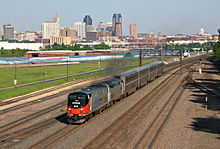Empire Builder
The Empire Builder is a daily long-distance passenger train operated by Amtrak between Chicago and either Seattle or Portland via two sections west of Spokane.
Introduced in 1929, it was the flagship passenger train of the Great Northern Railway and was retained by Amtrak when it took over intercity rail service in 1971.
The service also used to operate west from the Twin Cities before turning northwest in Willmar, Minnesota, to reach Fargo.
[13] During summer months, on portions of the route, "Trails and Rails" volunteer tour guides in the lounge car give commentary on points of visual and historic interest that can be viewed from the train.
[20] On March 7, 1966, the eastbound Empire Builder suffered a head-on collision with a Western Star mail and passenger train going in the opposite direction.
[35] The current Amtrak Empire Builder passes through Oregon, Washington, Idaho, Montana, North Dakota, Minnesota, Wisconsin, and Illinois.
It makes service stops in Spokane, Washington; Havre, Montana; Minot, North Dakota; and Saint Paul, Minnesota.
[50] The combined train then traverses the mountains of northeastern Washington, northern Idaho and northwestern Montana, arriving in Whitefish in the morning.
Passengers can see sweeping views as the Builder travels along the middle fork of the Flathead River, crossing the Continental Divide at Marias Pass.
After crossing Marias Pass, the Empire Builder leaves Glacier National Park and enters the Northern Plains of eastern Montana and North Dakota.
The service travels southeast through rural south-central Wisconsin, turns due south at Milwaukee, and ends at Chicago Union Station.
The eastbound Seattle and Portland sections leave within five minutes of each other just before the afternoon rush, combining in Spokane and traveling through Montana overnight before arriving at Glacier National Park in mid-morning and Williston at dinner time.
Stops at Milwaukee Airport and Sturtevant were added beginning March 21, 2020, to replace Hiawatha trains suspended due to the COVID-19-related drastic drop in demand.
The line has come under threat from flooding from the Missouri, Souris, Red, and Mississippi Rivers, and has occasionally had to suspend or alter service.
Most service gets restored in days or weeks, but Devils Lake in North Dakota, which has no natural outlet, is a long-standing threat.
[52] In spring 2011, the lake reached 1,454.3 ft (443.27 m),[53] causing service interruptions on windy days when high waves threatened the tracks.
In that case, the Empire Builder would have been rerouted to the south, ending service to Rugby, Devils Lake, and Grand Forks.
[55] In December 2011, North Dakota was awarded a $10 million TIGER grant from the US Department of Transportation to assist with the state portion of the cost.
In the spring and summer of 2011 flooding of the Souris River near Minot, North Dakota blocked the route in the latter part of June and for most of July.
The resulting congestion led to rampant delays for the Empire Builder, with the train running on time 44.5% in November 2013, the worst on-time performance of any Amtrak route and well below congressional standards.
In some cases, the delays resulted in an imbalance of crew and equipment, forcing Amtrak to cancel runs of the Empire Builder.
[60] This was a marked change from past years in which the Empire Builder was one of the best on-time performers in the entire Amtrak system, ahead of even the flagship Acela Express.
The Amtrak announcement also said that BNSF was working on adding track capacity, and it was anticipated that sometime in 2015 the Empire Builder could be returned to its former schedule.
[62][60] Even during the worst of the delays, the train has seen frequent patronage from workers in the Bakken fields and their families who board and detrain in Williston.
[65] In Minnesota, the Empire Builder returned to Saint Paul Union Depot on May 7, 2014, 43 years after it last served the station the day before the start of Amtrak.
In 1951 the Empire Builder was re-equipped with six new streamlined trainsets; the 1947 cars were used to launch the Western Star, while the Oriental Limited was retired.








